
Museums.
We have toured a veritable multitude of museums.
History museums, mining museums, art museums, The Smithsonian Museum and even a museum full of nutcrackers, but if I was forced to choose just one museum that every American citizen should visit, it would be this one.
The National WWII Museum in New Orleans is a Smithsonian affiliated museum and as such, it’s exhibits are exquisite and beautifully immersive, but it wasn’t always that way.
I thought New Orleans seemed to be an odd place for a museum about WWII. To my knowledge, the city didn’t boast any more involvement with the war effort than any other American city. Again, I was wrong.
The museum opened as the D-Day museum, on June 6th, 2000, the 56th anniversary of D-Day. It originally focused on the amphibious invasion of Normandy. The Higgins Boats, vital to amphibious operations were designed, built and tested in New Orleans by Higgins Industries. Surrounded by water as it is, the city was the natural home for such a project. Furthermore, Stephen Ambrose, historian and author of the book D-Day spearheaded, the effort to build the museum here.
In 2003 Congress designated the museum as America’s Official National WWII Museum. Since that time it has continued to expand, adding galleries which focus on every aspect of the war, from every front.
Today, the museum is a six acre campus, with five soaring pavilions which include a period dinner theater and old time soda shop. Two additional pavilions, a hotel and an atrium are currently under construction.
We parked in the large parking structure on Magazine street. As we approached the campus, it was so large that it took a minute to get our bearings. Once inside, the experience began immediately. The lobby is designed to look like a bustling WWII era train station, including a train car and changing departure board overhead.

To the left, in this picture, is an original Higgins Boat, the entire reason this museum exists. Of course I forgot to take a picture of it.

A ticket to the museum costs $28.00, it includes all exhibits in every building. There are two optional exhibits which cost $7.00 each. The first is a 4 D movie called Beyond All Boundaries, it’s shown hourly and you are assigned a scheduled time. The movie is narrated by Tom Hanks and is a visceral journey through the war from the perspective of those who lived it. It includes archival war footage, fog, flashes and bangs and theatrical elements. It was a profound experience. Do not miss it!
The second add-on option is Final Mission: USS Tang Submarine. It’s an immersive experience aboard a submarine. Only 27 people at a time are allowed to board. Each person is given a crew member ID and may be called on to perform duties during the battle. The docent said there would be enough time to do all experiences but we are notoriously slow while touring museums and didn’t think we’d have enough time.
After purchasing tickets, the exhibits begin with the train car shown below. A conductor welcomes you aboard and you are promptly whisked back in time. The car rumbles and jolts. Farmlands, towns and train stations flash by on the windows. Video monitors on the seat backs in front of you show young people going off to war. Stories are told in the voices of the enlisted and with their youthful faces on the screens, it’s easy to be completely immersed in the time period and patriotism swells in your heart.

After the train journey, you can explore the exhibits on your own. The galleries are arranged in a logical time sequence of the war. Interspersed here and there are specialty galleries which focus on one aspect or another.
It’s been many years since I studied World War II and while I know the generalities, there were many things I did not know or perhaps forgot. One of the things I found most interesting, was the status of the United states at the very beginning of the conflict. While the rest of the world had built up a semi-technological, war machine, the United States still relied predominantly on horseback calvary.
Plus we were woefully short on personnel.
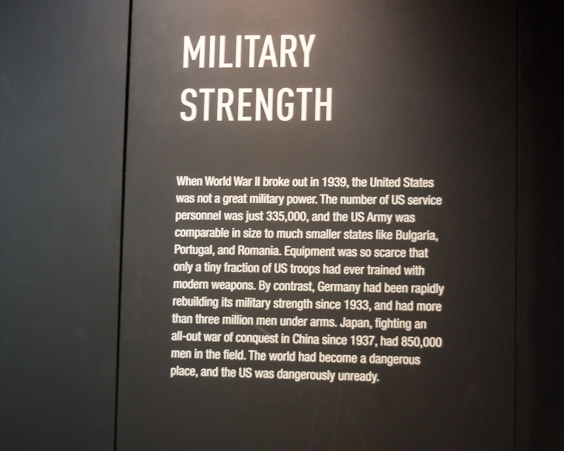

As we entered the first hall, it was very crowded.
This gallery focused on the build up of Hitler’s army, the stirrings of war and told the stories of the major players.


One of the things I liked about this museum was that exhibits could be enjoyed in a variety of ways. Working your way around the room, you could read signs and look at artifacts. Or you could watch a video on the wall, which was telling the same story through narration and archival footage.
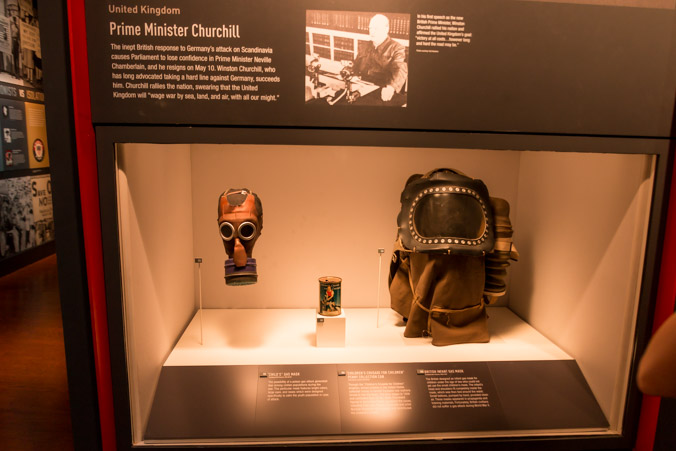
Part of the reason I believe all Americans should visit this place is told in the next series of pictures.
After the attack on Pearl Harbor, the United States had no choice but to enter the war, unprepared or not. It was at this time that Americans, rich and poor, young and old, men and women, came together for the greater good, in a way not seen before or since. Some efforts, like rationing and the draft, were perhaps involuntary but time and again, American companies and people worked together to protect our freedoms.
If we, the American people could learn from our mistakes and bond together in that way again, the world would be a better place.

Bonds, rationing, collecting scrap, patriotic propaganda, FDR’s fireside chats, all focused on one goal.
Victory!



Hollywood did their part, entertaining troops and making films for the war department.
Major companies retrofitted their plants to make war machines instead of consumer goods.



Unfortunately, war is not pretty. Japanese internment camps were the ugly result of a nation acting from fear.


Training new soldiers. What is that plane flying overhead?

Tag embossing machine. Dog tags.

Exhibit case after exhibit case… on and on…this museum is huge. The cases contain the uniforms and accoutrements for every American military unit and many of the allies. The one above is the French Allied Expeditionary Force.
One of the most interesting artifacts is this guy.

This is a Rupert paradummy. They were created for use during D-Day to create the illusion of a huge invasion. Just under three feet tall, these dummies were dressed in paratrooper uniforms, including helmets and boots. Filled with straw or sand, they also carried recordings of gunfire and exploding mortar rounds to add to the authenticity. A few live soldiers landed with them, bringing more special effects such as flares and chemicals. Upon landing, the Ruperts would explode and self destruct, leaving only charred parachute behind.
From this point on, the museum becomes even more intense. The galleries are designed to create the feeling of being on the battlefield with the soldiers marching all around. Archival footage and sounds are projected on various surfaces and it really feels like being there.




This section was particularly profound for me as this would have been where my father served. He was a sharpshooter in the army. He was shot in the leg while attempting to capture a bridge. His commanding officer pulled him to safety. Hearing the shouts of the men as they marched by on the screens was awe inspiring and frightening.

This display shows the debris of a battlefield. The objects left behind.
I cannot even imagine.

We move on to more battles, bombed out buildings, inside and out with videos projected on the walls.


Entering the bridge of a ship, on our way to the Pacific Theater.

Para troopers and shore landings.

The battles of the Pacific.

Sights and sounds of battle and planned movements in archival footage projected on sheets. I could just picture the soldiers and sailors watching movies on sheet screens like these.

Archival videos of the battle front.


The weapons of the Pacific.


Japanese occupied islands.

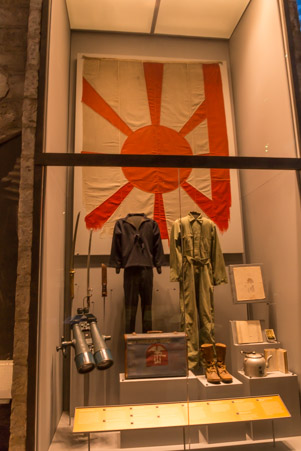
Iwo Jima.
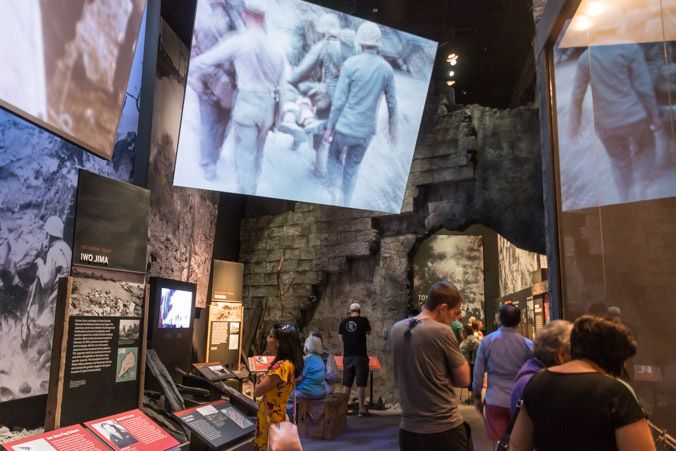


The final gallery is a memorial to Hiroshima and Nagasaki. The space is dark and black and difficult to photograph but these are the few pictures I took.

Video of the bombing.

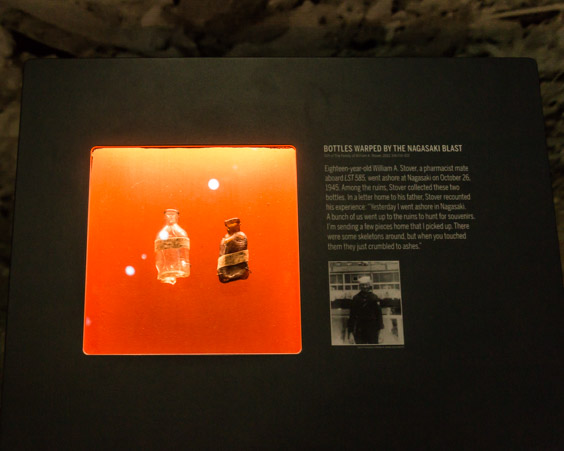
Video of the surrender.

The gallery was very small but it was a tasteful and moving memorial.
The only pavilion we hadn’t yet visited was the US Freedom Pavilion: The Boeing Center. This building was around the block in a separate entrance. The pavilion is a huge open space, with airplanes hanging from the ceiling and a multi-story glass catwalk around the perimeter.
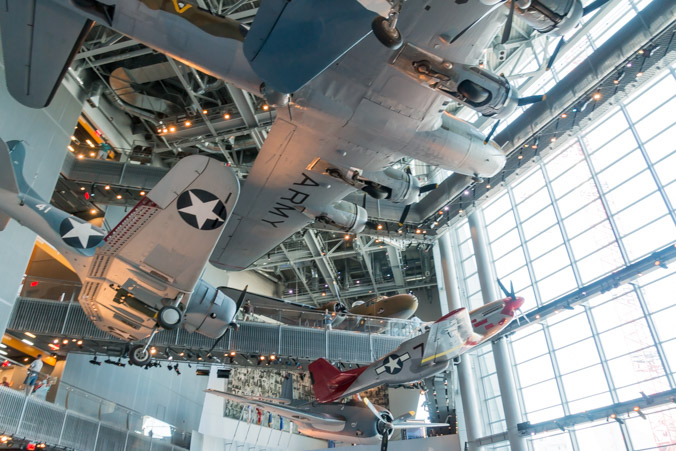
The most notable plane (shown below), is a B17-E-BO Flying fortress called My Gal Sal. During WWII the pilot was forced to land on the Greenland ice cap. The crew was rescued after nine days and the plane was abandoned. It was recovered 31 years later and restored. Today it resides here.


Besides airplanes, there is a small collection of uniforms showing every branch of the military.

The Army, in honor of my father, a sharpshooter.

The Navy, in honor of my father in law who spent his 21st birthday on a lifeboat. The Liberty ship he was serving on was bombed out from under him.
The most impressive part of this exhibit hall are the catwalks. They enable you to see the planes close up, from multiple levels. They are REALLY high.
The elevator has a warning sign.
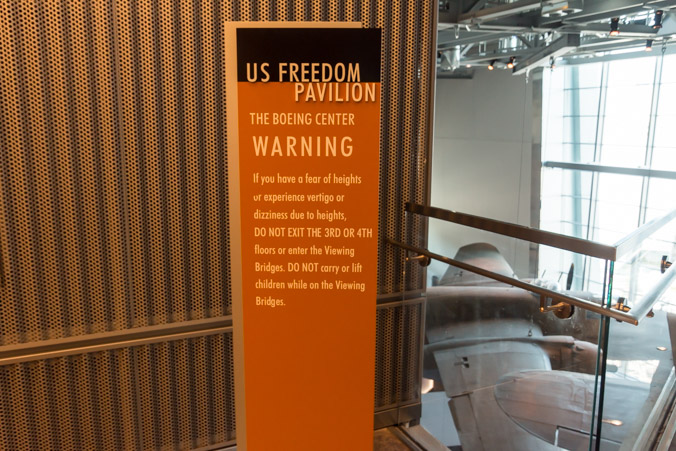
While I am VERY scared of heights I will not allow it to get the best of me.
Up we go!

Level three, not too bad.

Level four is very, very high.


Pictures do not do it justice…the people below are very small! Did I mention that it’s glass enclosed?
Great view of the skyline and Superdome though.

This ends our tour of the national WWII Museum, it is closing time. It easily took all day to see everything and that was not including the submarine experience. We stopped mid day for a quick bite at the little soda shop, called Jerry Nims. It’s located on the outside corner of the main complex. Perfectly designed to look like an old corner soda shop. They offer sandwiches and snacks. A more formal restaurant is also available but it would be difficult to fit a leisurely meal in and still see everything. When the new pavilions are added, this could be a multiple day experience. Plan accordingly, take your time and see it all!
Till next time!
I’ve heard fantastic things about this museum – it’s been on my list for awhile! Thanks for the sneak peek!
LikeLike